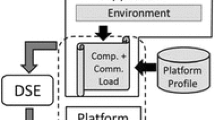Abstract
Systems for distributed event processing have recently gained increasing attention in a broad range of application domains. This raises the demand for methods to adapt the system design to application-specific needs. Our approach considers (1) trade-offs regarding the hardware infrastructure and (2) trade-offs in the software design. For the underlying model we categorize events along the dimensions of temporal complexity and physical distribution. This yields a categorization of events that drives trade-offs in the infrastructure design. The presented model supports design decisions in dependence on application-specific event properties and design goals.



Similar content being viewed by others
Notes
The active database community often refers to “Event—Condition—Action (ECA)‘’ rules. That is, events occur and if they follow some condition some action is taken.
References
Ahmad, Y., & Çetintemel, U. (2004). Network-aware query processing for stream-based applications. In VLDB ’04: Proceedings of the thirtieth international conference on very large data bases (pp. 456–467). VLDB Endowment.
Arasu, A., Babu, S., & Widom, J. (2006). The cql continuous query language: Semantic foundations and query execution. The VLDB Journal, 15(2), 121–142.
Bornhövd, C., Lin, T., Haller, S., & Schaper, J. (2004). Integrating automatic data acquisition with business processes experiences with sap’s auto-id infrastructure. In VLDB ’04: Proceedings of the thirtieth international conference on very large data bases (pp. 1182–1188). VLDB Endowment.
Carlson, J., & Lisper, B. (2004). An event detection algebra for reactive systems. In Proc. of the 4th ACM intl. conf. on embedded software (EMSOFT). New York, NY, USA: ACM.
Chakravarthy, S., & Mishra, D. (1994). SNOOP: An expressive event specification language for active databases. Journal of Data and Knowledge Engineering, 14(1).
Decker, C., Kubach, U., & Beigl, M. (2003). Revealing the retail black box by interaction sensing. In ICDCSW ’03: Proceedings of the 23rd international conference on distributed computing systems (p. 328). Washington, DC, USA: IEEE Computer Society.
Doolin, D., & Sitar, N. (2005). Wireless sensors for wildfire monitoring. In Proceedings of the SPIE symposium on smart structures & materials/ NDE 2005.
Franklin, M. J., Jeffery, S. R., Krishnamurthy, S., & Reiss, F. (2005). Design considerations for high fan-in systems: The hifi approach. In Proc. of the int. conf. on innovative data systems research (CIDR).
Gatziu, S., & Dittrich, K. R. (1992). SAMOS: An active object-oriented database system. IEEE Quarterly Bulletin on Data Engineering, Special Issue on Active Databases, 15(1–4), 23–26.
Guerrero, P. E., Sachs, K., Cilia, M., Bornhövd, C., & Buchmann, A. (2007). Pushing business data processing towards the periphery. In 23rd international conference on data engineering (ICDE’07) (pp. 1485–1486). New York, NY: IEEE Computer Society.
GTZ-Potsdam (2007). German indonesian tsunami early warning system. http://www.gitews.org/.
Ivanytsynova, L., Ziekow, H., Günther, O., Kletti, W., & Kubach, U. (2008). Six case studies. In O. Günther, W. Kletti, U. Kubach (Eds.), RFID in manufacturing. Berlin, Heidelberg: Springer.
Kounev, S., Sachs, K., Bacon, J., & Buchmann, A. (2008). A methodology for performance modeling of distributed event-based systems. In ISORC ’08: Proceedings of the 2008 11th IEEE symposium on object oriented real-time distributed computing (pp. 13–22). New York, N. Y.: IEEE Computer Society. doi:10.1109/ISORC.2008.51.
Madden, S., Franklin, M. J., Hellerstein, J. M., & Hong, W. (2002). Tag: A tiny aggregation service for ad-hoc sensor networks. SIGOPS Operating Systems Review, 36(SI), 131–146.
Madden, S. R., Franklin, M. J., Hellerstein, J. M., & Hong, W. (2003). The design of an acquisitional query processor for sensor networks. In Proceedings of the ACM SIGMOD.
Muehl, G., Fiege, L., & Pietzuch, P. R. (2006). Distributed event-based systems. New York: Springer.
Pietzuch, P. R., Ledlie, J., Shneidman, J., Roussopoulos, M., Welsh, M., & Seltzer, M. I. (2006). Network-aware operator placement for stream-processing systems. In ICDE (p. 49).
Ratnasamy, S., Karp, B., Shenker, S., Estrin, D., Govindan, R., Yin, L., et al. (2003). Data-centric storage in sensornets with GHT, a geographic hash table. Mobile Networks and Applications (MONET), 8(4), 427–442. (Special Issue on Wireless Sensor Networks).
Srivastava, U., Munagala, K., & Widom, J. (2005). Operator placement for in-network stream query processing. In Proceedings of ACM SIGMOD-SIGACT-SIGART symposium on principles of database systems (PODS). New York, NY, USA: ACM.
Terfloth, K., Hahn, K., & Voisard, A. (2007). On the cost of shifting event processing within wireless environments. In Proceedings of the dagstuhl event processing workshop.
Wieland, M., Griesser, L., & Kuendig, C. (2000). Seismic early warning system for a nuclear power plant. In Proceedings of the 12th world conference on earthquake engineering (WCEE 2000).
Yao, Y., & Gehrke, J. (2003). Query processing for sensor networks. In ICDCSW ’03: Proceedings of the 23rd international conference on distributed computing systems.
Zimmer, D., & Unland, R. (1999). On the semantics of complex events in active database management systems. In ICDE ’99: Proceedings of the 15th international conference on data engineering (p. 392). New York, NY, USA: IEEE Computer Society.
Acknowledgements
We wish to thank Katharina Hahn and Kirsten Terfloth for useful feedback. Part of this work beneficiated from collaboration with them. A proportion of work on this paper was carried out when Agnès Voisard was visiting the International Computer Science Institute in Berkeley, USA.
Author information
Authors and Affiliations
Corresponding author
Rights and permissions
About this article
Cite this article
Voisard, A., Ziekow, H. Modeling trade-offs in the design of sensor-based event processing infrastructures. Inf Syst Front 14, 317–330 (2012). https://doi.org/10.1007/s10796-010-9248-y
Published:
Issue Date:
DOI: https://doi.org/10.1007/s10796-010-9248-y




